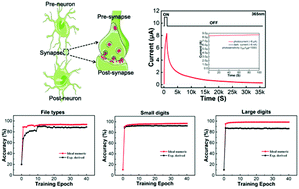High photosensitivity light-controlled planar ZnO artificial synapse for neuromorphic computing†
Abstract
A light-controlled artificial synapse, which mimics the human brain has been considered to be one of the ideal candidates for the fundamental physical architecture of a neuromorphic computing system owing to the possible abilities of high bandwidth and low power calculation. However, the low photosensitivity of synapse devices can affect the accuracy of recognition and classification in neuromorphic computing tasks. In this work, a planar light-controlled artificial synapse having high photosensitivity (Ion/Ioff > 1000) with a high photocurrent and a low dark current is realized based on a ZnO thin film grown by radiofrequency sputtering. The synaptic functions of the human brain such as sensory memory, short-term memory, long-term memory, duration-time-dependent-plasticity, light-intensity-dependent-plasticity, learning-experience behavior, neural facilitation, and spike-timing-dependent plasticity are successfully emulated using persistent photoconductivity characteristic of a ZnO thin film. Furthermore, the high classification accuracy of 90%, 92%, and 86% after 40 epochs for file type datasets, small digits, and large digit is realized with a three-layer neural network based on backpropagation where the numerical weights in the network layer are mapped directly to the conductance states of the experimental synapse devices. Finally, characterization and analysis reveal that oxygen vacancy defects and chemisorbed oxygen on the surface of the ZnO film are the main factors that determine the performance of the device.



 Please wait while we load your content...
Please wait while we load your content...